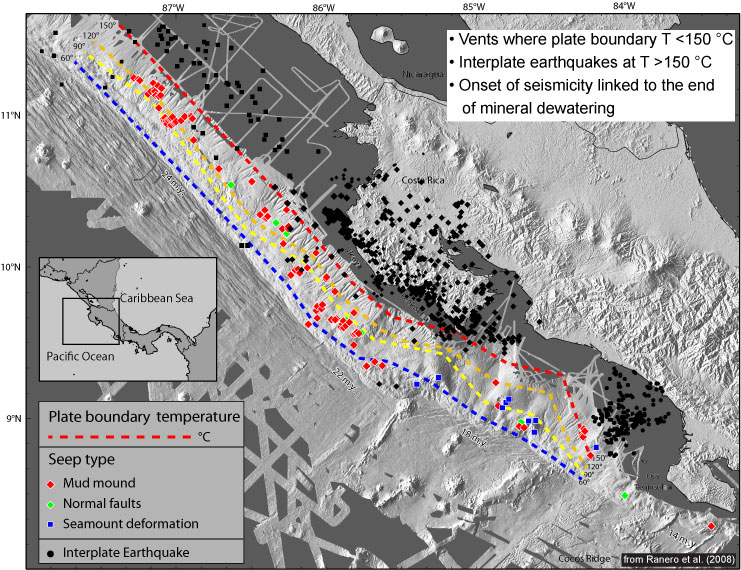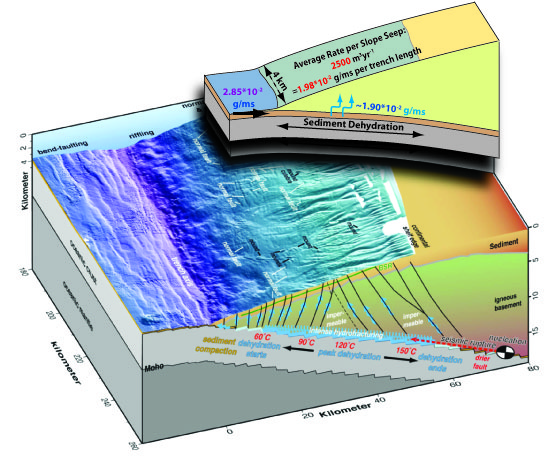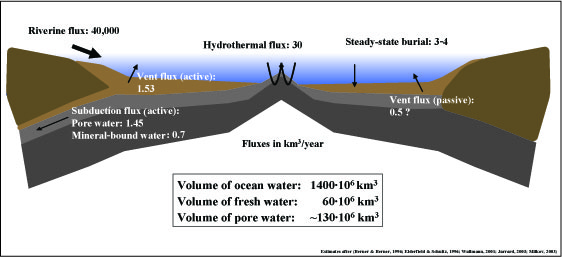 Web Content Display Web Content Display Fluid dewateringOne of the most important results of SFB 574 was the development of a new hydrogeological model for an erosive convergent margin and its effect on forearc tectonics and interplate seismogenesis (Ranero et al., 2008). Dewatering features are concentrated at mid-slope depths. In a number of places, seamount subduction seems to enhance mass wasting and the formation of mounds along the scarp margins. Seismic profiles show that mounds and vent sites are underlain by relatively undeformed slope sediment and likely fed by fault-controlled fluid pathways which may even originate at the plate boundary several kilometers below the seafloor (Ranero and von Huene, 2000; Hensen et al., 2004). In general, fluids are depleted with respect to seawater chloride and other major elements, suggesting a general process of freshwater addition and thus a common source of the fluids. d18O-dD systematics of fluid endmembers indicate that smectite to illite transformation is the principal cause for these anomalies (Hensen et al., 2004). Since the temperature range (60-150°C) required for the smectite to illite transformation is not reached in the forearc, but thermogenically formed CH4 has been detected in the mound fluids (Schmidt et al., 2005), we hypothesize that freshened fluids are derived from subducting sediments and migrate upward along deep-seated faults. Interestingly, the occurrence of vent sites matches the temperature range required for clay mineral dewatering at the plate boundary and the end of dewatering is marked by the onset of interplate earthquakes (Fig. 1).
Figure 1: Distribution of dewatering sites (seeps) along the Central American forearc in relation to temperature at the plate boundary and occurrence of interplate earthquakes (after Ranero et al., 2008 and Sahling et al., 2008).
Figure 2 summarzes the processes described above and shows an approximate fluid budget for the recycling of mineral-bound water on a representative 4 km-long section of the trench. A recent study combining data on bathymetry, sidescan sonar and seafloor observations revealed unequivocal evidence for the existence of about 110 vent sites along the 460 km long continental slope off Costa Rica and Nicaragua (Sahling et al., 2008). On average, this means the occurrence of one seep every four kilometers along the slope. Based on this calculation, the average fluid discharge of 2,500 m3 yr-1 per vent site (Ranero et al., 2008), equivalent to 1.98 * 10-2 g/ms flux per unit trench length, may be quantitatively driven by mineral-bound water released at elevated temperatures at the plate boundary (about 2/3 of the input of 2.85*10-2 g/ms).
Figure 2: Cross section characterizing the geological structure offshore southern Costa Rica. Deep-seated faults cutting through basement complex and upper-plate sediments provide pathways for fluid advection. Inset shows estimated rates for mineral-bound water input, dewatering along the plate boundary, and escape through seafloor seepage.
Overall, vent fluxes are comparatively low (about on order of magnitude lower than estimated pore water input to subduction zones). For the Central American margin we estimated a mean vent flux of about 600 m3 yr-1 per kilometer trench. Projected to the global length of subduction zones (44,000 km) this would sum up to about 0.03 km3 yr-1, which is only 2% of the currently used estimate from the early 1990ies (Von Huene and Scholl, 1991; Fig. 3). One reason for this substantial mismatch is that much of the pore water is squeezed-out at early stages of subduction and accretion, whereas cold vents are often fed by deeply sourced fluids and are highly enriched in a number of elements and compounds (e.g. CH4, B, Li, I, etc.) resulting in considerable element fluxes. However, this large discrepancy requires a re-evaluation of available global data sets on cold vents which is the goal of TP B5 in the final funding phase of SFB 574.
Figure 1: Compilation of global water fluxes from published sources (Kastner et al., 1991; Von Huene and Scholl, 1991; Elderfield and Schultz, 1996; Wallmann, 2001; Jarrard, 2003). Water fluxes at cold vents are quite low and highly unconstrained, but may gain quantitative importance for a number of highly enriched elements and compounds.
References
Elderfield, H. and Schultz, A., 1996. Mid-Ocean Ridge hydrothermal fluxes and the chemical composition of the ocean. Annual Review of Earth and Planetary Sciences 24, 191-224. Hensen, C., Wallmann, K., Schmidt, M., Ranero, C. R., and Suess, E., 2004. Fluid expulsion related to mud extrusion off Costa Rica continental margin - a window to the subducting slab. Geology 32, 201-204. Jarrard, R. D., 2003. Subduction fluxes of water, carbon dioxide, chlorine, and potassium. Geochem. Geophys. Geosyst. 4. Kastner, M., Elderfield, H., and Martin, J. B., 1991. Fluids in convergent margins: what do we know about their composition, origin, and role in diagenesis and importance for oceanic chemical fluxes? Phil. Trans. R. Soc. London, Ser. A 335, 243-259. Lu, Z., Hensen, C., Fehn, U., and Wallmann, K., 2008. Halogen and 129I systematics in gas hydrate fields at the northern Cascadia margin (IODP Expedition 311): Insights from numerical modeling. Geochem. Geophys. Geosyst. 9. Ranero, C. R., Grevemeyer, I., Sahling, H., Barckhausen, U., Hensen, C., Wallmann, K., Weinrebe, W., Vannucchi, P., von Huene, R., and McIntosh, K., 2008. Hydrogeological system of erosional convergent margins and its influence on tectonics and interplate seismogenesis. Geochem. Geophys. Geosyst 9. Sahling, H., Masson, D. G., Ranero, C. R., Hühnerbach, V., Weinrebe, W., Klaucke, I., Bürk, D., Brückmann, W., and Suess, E., 2008. Fluid seepage at the continental margin offshore Costa Rica and southern Nicaragua. Geochem. Geophys. Geosyst 9. von Huene, R. and Scholl, D. W., 1991. Observations at Convergent Margins Concerning Sediment Subduction, Subduction Erosion, and the Growth of Continental Crust. Rev. Geophys. 29. Wallmann, K., 2001. The geological water cycle and the evolution of marine d18O values. Geochim. Cosmochim. Acta 65, 2469-2485. |  Events Events Wie funktioniert die Recyclingmaschine der Erde?Nach elf Jahren endet der Kieler Sonderforschungsbereich 574 zu Subduktionszonen Teilprojekt ÖffentlichkeitsarbeitMEERESFORSCHUNG FÜR MICH UND DICH | |
©SFB574 // Wischhofstrasse 1-3 // D-24148 Kiel // T. +49 (0)431 600 1413 // elange [AT] geomar.de










